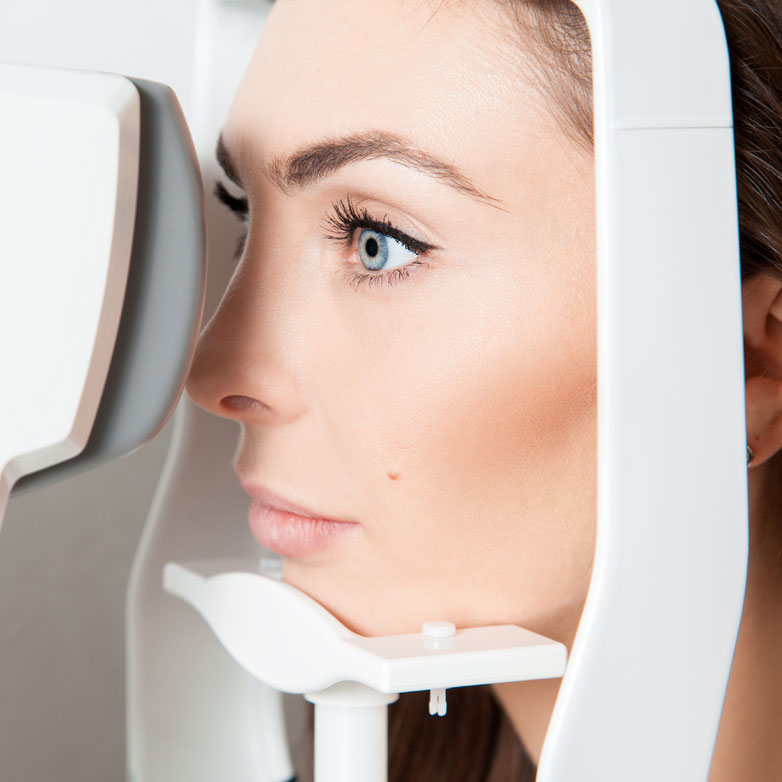Fuchs’ endothelial dystrophy is a progressive disease that leads to clouding of the cornea and eventual reduction in vision. Patients with Fuchs’ may notice this as foggy vision which can be like looking through a misted window.
What is Fuchs' dystrophy?
Fuchs’ endothelial dystrophy is a progressive disease resulting in clouding of the cornea and eventual reduction in vision. It affects the corneal endothelial cells which are a specialised single layer of cells on the back surface of the cornea that pump water out of it. When healthy, this keeps the cornea thin and clear.
Endothelial cells do not have the ability to regenerate and hence if they are damaged the cornea gradually begins to swell with water, making it hazy and leading to loss of vision.

What are the symptoms of Fuchs' dystrophy?
A healthy cornea is clear and bright, however, in advanced Fuchs’ dystrophy, the cornea can become hazy and dull due to swelling which affects your quality of vision. Typical symptoms include:
- Foggy vision, particularly in the morning when you wake up
- Glare and haloes around bright lights
- Typically, vision begins to improve toward the end of the day but this may not happen in advanced cases
If you suffer from cloudy or reduced vision and would like to discuss potential Fuchs’ dystrophy treatment options, make an enquiry or call us on (02) 9452 6444.
What are the treatment options for Fuchs' dystrophy?
Medical treatment
During the early stages of Fuchs’ dystrophy when corneal swelling is still mild, your surgeon may prescribe you sodium chloride (salt) drops or ointment. By increasing the salt content of the tears water is drawn out of the cornea by osmosis.
Salt drops do not cure Fuchs’ Dystrophy, they simply delay the need for surgery in early cases.
Surgical treatment
The surgical treatment is endothelial transplantation which involves the transplantation of healthy endothelial cells to replace the absent or diseased cells and may be combined with cataract surgery. The gold standard of corneal transplantation for Fuchs Dystrophy is an operation called endothelial keratoplasty (DSAEK or DMEK surgery).
It is no longer considered modern practice to perform full thickness corneal transplantation (PK) for Fuchs’ dystrophy.
DSAEK (Descemets Stripping Automated Endothelial Keratoplasty) Endothelial Transplantation Surgery
DSAEK surgery entails introducing a thin layer of donor corneal tissue one-tenth of a millimetre thick with healthy endothelial cells into the front compartment of the patient’s eye via very small incisions. The new endothelial cell layer is then floated upwards until it makes contact with the back surface of the patient’s cornea. An air bubble is then positioned behind the graft tissue which is then pressed into position. No stitches are used to hold the graft in position. Some air is left in the eye at the end of surgery and the patient is asked to lie flat for at least an hour after surgery so that the air bubble continues to support the new layer of cornea in position. Surgery can be performed under local or general anaesthesia.
DMEK (Descemets Membrane Endothelial Keratoplasty) endothelial transplants
In DMEK surgery the diseased endothelium is removed and replaced with a sheet of pure endothelial cells from a donor just a hundredth of a milimetre thick. The significant advantages of DMEK include faster visual recovery compared to DSAEK and a rejection rate lower than 1%. However, not all patients are suited to have DMEK surgery and your surgeon will discuss this with you. Surgery can be performed under general or local anaesthesia.
Cataract Surgery and Fuchs’ Dystrophy
Routine cataract surgery in patients with Fuchs’ dystrophy can accelerate corneal failure unless particular care, and an alteration to the standard technique of surgery, is made to minimise corneal endothelial cell damage (soft shell technique). Ideally your surgery should be undertaken by a corneal surgeon that is familiar with the management of patients with Fuchs’ dystrophy. In moderate to advanced cases of Fuchs’ dystrophy your surgeon may decide to perform cataract surgery and endothelial corneal transplantation at the same time.
Read more about cataract surgery at Forest Eye Surgery
All surgical procedures carry some risk. The information provided here is for general educational purposes only. Please contact Forest Eye Surgery to find out if eye surgery is appropriate for your individual situation.
For appointments and enquiries call (02) 9452 6444
Our rooms are open 8:30 am - 5:00 pm Monday to Friday
Unit 11, Building 7
49 Frenchs Forest Rd East
Frenchs Forest NSW 2086
info@foresteyesurgery.com.au
Phone: (02) 9452 6444
Fax: (02) 9452 6566
